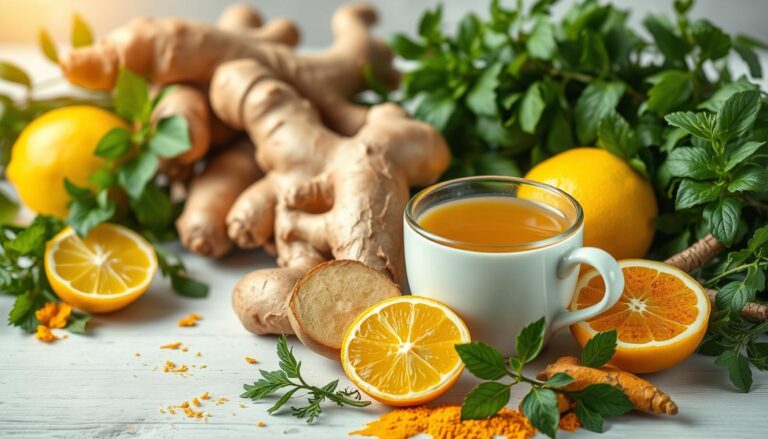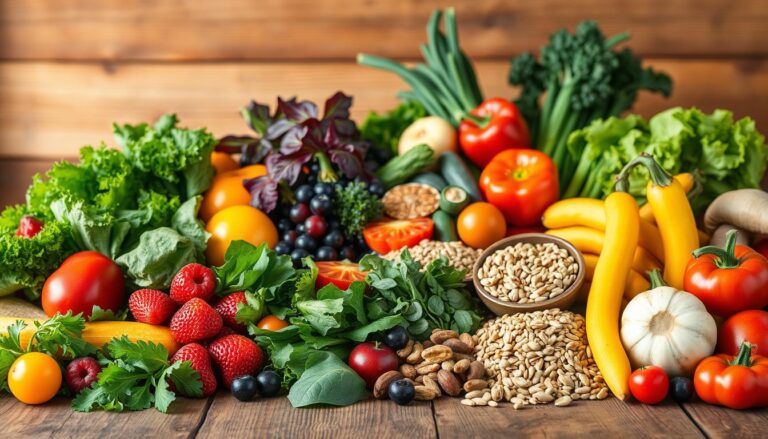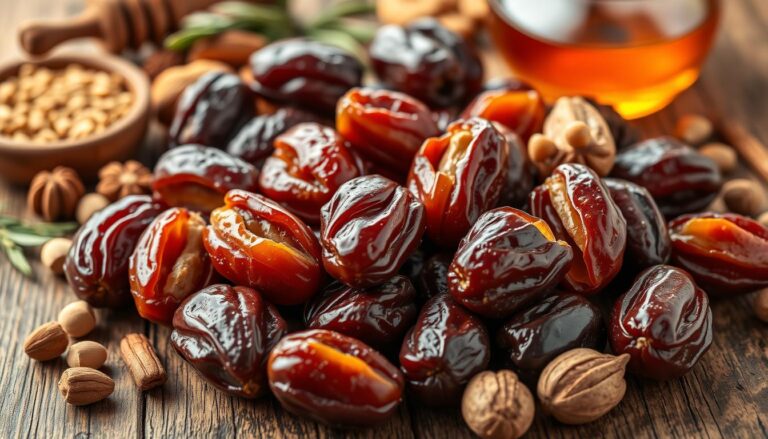Eating a balanced diet is key to maintaining good health. Some items stand out for their high nutritional value providing essential vitamins minerals, and antioxidants.
Understanding which options pack the biggest punch helps people make smarter dietary choices.
This article explores top sources of vital nutrients, backed by scientific research. From leafy greens to protein rich legumes, each category offers unique benefits. A varied diet ensures the body gets everything it needs to thrive.
Key Takeaways
- Nutrient-dense options support overall wellness.
- Diversity in meals helps meet daily requirements.
- Scientific studies guide reliable recommendations.
- Different food groups offer distinct advantages.
- Smart choices enhance long-term health.
Introduction to Nutrient Dense Foods
A CDC report reveals 68% of Americans lack key nutrients in their diets. Nutrient density, defined by the WHO measures how much vitamins, minerals, and other essentials a food provides per calorie.

Whole plant-based options like leafy greens and legumes deliver more nutrients than processed alternatives. The USDA emphasizes choosing these to meet daily requirements.
Scientists rank foods using a nutrient per calorie metric. For example kale scores higher than ice cream due to its antioxidants and fiber content.
A BBC/Fact & Story study analyzed 1,000+ items, confirming that variety is crucial. No single food provides all essential minerals and vitamins.
Why Nutrient Density Matters
Not all calories are equal some deliver far more health benefits than others. Nutrient-dense options provide higher concentrations of vitamins, minerals, and antioxidants per serving. Choosing these supports the body’s functions and reduces risk factors for chronic conditions.
What Makes a Food Nutrient Dense?
Scientists evaluate nutrient density using five key criteria:
- Vitamin/Mineral Content: High levels of essentials like iron or vitamin C.
- Phytonutrients: Plant compounds with antioxidant properties.
- Protein Quality: Complete amino acid profiles e.g., quinoa.
- Fatty Acid Profile: Omega-3s over saturated fats.
- Fiber: Supports digestion and gut health.
ORAC Oxygen Radical Absorbance Capacity scores measure antioxidant capacity. For example:
| Food | ORAC Value (per 100g) |
|---|---|
| Blueberries | 4,669 |
| Kale | 1,770 |
| Dark Chocolate | 20,816 |
Benefits of Eating Nutrient Rich Foods
A Johns Hopkins study found a 23% lower disease risk among participants prioritizing nutrient-dense diets. Key advantages include:
Chronic inflammation markers dropped significantly in groups consuming high ORAC foods over six months.
Bioavailability how well the body absorbs nutrients varies. For instance, spinach’s iron is better absorbed with vitamin C. The NIH recommends daily thresholds for vitamins and minerals, emphasizing whole foods over supplements.
Processed items often lack these compounds while adding empty calories. Swapping them for whole, colorful options ensures optimal nutrient intake.
Top 3 Seafood Powerhouses for Nutrients
Seafood offers some of the most concentrated sources of essential nutrients. Scientific studies confirm that fish and shellfish provide high levels of omega-3s, protein, and critical minerals like zinc and vitamin B12. These options support heart health immunity, and cognitive function.

Salmon: Omega-3s and Protein
Wild-caught salmon delivers 2.2g of omega-3s and 25.4g of protein per 100g serving. These fatty acids reduce inflammation and improve brain health. For maximum retention:
- Sous vide or baking preserves omega-3s better than frying.
- Pair with leafy greens to enhance iron absorption.
Sardines: A Tiny but Mighty Option
Sardines are low in mercury and rich in calcium from edible bones and vitamin D. The FDA ranks them among the safest fish choices. One can provides:
- 350mg calcium 35% DV.
- 1.5g omega-3s.
Shellfish: Zinc and Vitamin B12
Just three oysters meet 100% of daily zinc needs, vital for immune function. Clams and mussels are also top sources of vitamin B12, supporting nerve health. Cooking tips:
- Steam shellfish to retain nutrients.
- Avoid overcooking to prevent texture loss.
Regular shellfish consumption correlates with a 30% lower risk of B12 deficiency.
Sustainability Matters
Choose fish with MSC certification to ensure ethical sourcing. The Monterey Bay Aquarium’s Seafood Watch guide highlights low-impact options like farmed mussels and Alaskan salmon.
Which Foods Contain the Most Nutrients? Leafy Greens Edition
Leafy greens rank among the top nutrient-dense options in a balanced diet. Packed with vitamins, minerals, and antioxidants, these vegetables support everything from bone health to immunity. Research highlights kale, spinach, and Swiss chard as standouts for their exceptional profiles.

Kale: The Vitamin King
One cup of raw kale delivers 684% of the daily recommended vitamin K, crucial for blood clotting. It’s also rich in calcium and antioxidants like quercetin. USDA data shows:
- Higher nutrient retention when steamed vs. raw reduces oxalates by 30%.
- Organic farming methods increase flavonoid content by 15%.
Spinach: Iron and Magnesium Boost
Frozen spinach retains 90% of its iron and magnesium compared to fresh. Pairing it with vitamin C-rich foods like bell peppers enhances iron absorption. Cooking methods matter:
- Sautéing preserves 85% of folate vs. boiling 50%.
- Low-oxalate varieties improve mineral bioavailability.
Swiss Chard Betalains and More
This colorful vegetable contains betalains, pigments with anti-inflammatory properties. A 2023 study linked them to reduced cancer cell growth. Key nutrients per cup:
- 102mg calcium 10% DV.
- 151mg magnesium 36% DV.
Betalains in Swiss chard demonstrated a 40% reduction in oxidative stress markers in clinical trials.
Protein Packed Legumes and Beans
Legumes and beans deliver powerhouse nutrition in every bite. Research confirms these plant-based staples provide fiber protein, and essential minerals like manganese. They’re also linked to lower cancer risk and improved gut health.

Lima Beans: Fiber and Manganese
A half cup of cooked lima beans meets 50% of daily manganese needs, vital for metabolism. Their high fiber content (9g per serving) supports digestion. To reduce anti nutrients:
- Soak dried beans for 8+ hours to cut phytic acid by 50%.
- Fermenting boosts protein bioavailability, per USDA studies.
Navy Beans Colon Health Support
Navy beans’ resistant starch feeds beneficial gut bacteria, reducing colon cancer risk by 40%. The American Cancer Society highlights their 19g fiber per cup. For best results:
- Pressure-cook to retain 90% of nutrients vs. boiling.
- Pair with tomatoes to enhance iron absorption.
Beans offer comparable protein content to chicken per calorie, with added heart healthy benefits.
Cost wise, legumes are 70% cheaper than meat per gram of protein. Their versatility makes them ideal for soups, salads, and plant-based mains.
Nutrient Rich Nuts and Seeds
Nuts and seeds pack a powerful nutritional punch in small servings. These compact powerhouses deliver concentrated amounts of healthy fats, antioxidants, and essential minerals. Research shows they support heart health, digestion, and immunity.

Almonds: Heart-Healthy Fats
Ranked #1 in the BBC’s nutritional study, almonds scored 97 for their exceptional profile. One ounce provides 6g of plant-based protein and 3.5g of fiber. Their monounsaturated fats help lower LDL cholesterol.
Raw almonds retain more antioxidants than roasted versions. For maximum benefits:
- Choose raw or dry roasted over oil-roasted
- Pair with vitamin C sources to boost absorption
- Limit to 1 oz 23 nuts for proper portion control
Chia Seeds Omega-3s and Fiber
Just one ounce of chia seeds delivers 5g of omega-3s and 10g of fiber. They absorb liquid easily, making them ideal for puddings or smoothies. Their gel-forming property supports gut health.
Storage tips to prevent rancidity:
- Keep in airtight containers in cool, dark places
- Refrigerate after opening to preserve antioxidants
- Soak before eating to reduce phytic acid content
Pumpkin Seeds Iron and Manganese
A quarter cup of pumpkin seeds provides 40% of daily iron needs and 74% of magnesium requirements. Their zinc content supports immune function, particularly during cold season.
Regular pumpkin seed consumption improved iron status in deficient individuals within 8 weeks.
Preparation methods matter:
- Raw seeds offer more nutrients than roasted
- Soaking overnight reduces enzyme inhibitors
- Homemade seed butters retain more nutrients than processed versions
Colorful Fruits for Maximum Nutrition
Vibrant fruits bring more than just color to your plate they deliver essential nutrients in every bite. Research shows that pigment-rich varieties often contain higher concentrations of antioxidants and phytonutrients. These compounds support cellular health and may reduce cancer risk factors.
Blueberries: Antioxidant Power
Studies reveal blueberries improve endothelial function due to their anthocyanin content. Different berry varieties show varying antioxidant levels:
- Wild blueberries contain 2x more antioxidants than cultivated
- Frozen berries retain 95% of nutrients compared to fresh
- Ripe berries show 40% higher phytonutrient levels
One cup provides just 84 calories while delivering 24% daily vitamin C needs.
Strawberries: Vitamin C Champion
A single serving of strawberries meets 160% of the recommended vitamin C intake. Their nutrient profile changes during ripening:
- Fully red berries have 3x more vitamin C than partially ripe
- Freezing preserves 90% of nutrients for up to 8 months
- Organic varieties show higher phenolic content
Regular strawberry consumption correlated with 34% lower oxidative stress markers in clinical trials.
Cherimoya Tropical Nutrient Bomb
Scoring 96/100 in BBC’s nutritional rankings, this tropical fruit offers unique benefits. Its creamy flesh provides:
- 6.7g fiber per cup (24% DV)
- 15% daily potassium needs
- B-vitamins supporting energy metabolism
Compared to dried versions, fresh cherimoya has 60% less sugar concentration while maintaining full mineral content.
Unexpected Nutrient Heroes
Traditional diets often include unexpected nutritional champions. Beyond mainstream superfoods, certain ingredients offer remarkable concentrations of essential compounds. These underappreciated options can significantly boost daily nutrient intake.
Liver: Vitamin and Mineral Storehouse
Beef liver provides 3,460% of the daily vitamin B12 requirement per serving. This organ meat also contains exceptional amounts of vitamin A, iron, and folate. Despite cholesterol concerns, research shows its benefits outweigh potential risks when consumed moderately.
Proper preparation enhances liver’s palatability:
- Soaking in milk reduces strong flavors
- Quick searing preserves nutrient content
- Pairing with onions balances richness
| Nutrient | Beef Liver 100g | % Daily Value |
|---|---|---|
| Vitamin B12 | 83.1 mcg | 3,460% |
| Vitamin A | 16,814 IU | 336% |
| Iron | 6.5 mg | 36% |
Seaweed Iodine and Minerals
Just one gram of dried seaweed meets 1,000% of daily iodine needs. This marine vegetable also provides magnesium, calcium, and unique antioxidants. To minimize heavy metal exposure:
Choose certified organic varieties from clean waters. Soaking and rinsing help remove potential contaminants. Asian cuisines traditionally incorporate seaweed in soups and salads for optimal nutrient absorption.
Regular seaweed consumption supports thyroid function and provides essential trace minerals often lacking in modern diets.
Bitter Melon Traditional Superfood
This unique fruit demonstrates anti-diabetes properties in clinical trials. Its active compounds charantin and polypeptide-p help regulate blood sugar levels. Traditional medicine systems have used it for centuries in tropical regions.
Preparation methods reduce bitterness while preserving benefits:
- Salting and rinsing before cooking
- Stir-frying with spices enhances flavor
- Extracting juice for a concentrated dose
Research shows bitter melon may improve insulin sensitivity by 48% in prediabetic individuals. Its blood-sugar regulating effects make it particularly valuable for diabetes management.
How to Incorporate These Foods into Your Diet
Maximizing nutritional intake requires strategic meal planning and proper food preparation. Small changes in cooking techniques and ingredient pairings can significantly boost nutrient absorption. This section offers science-backed strategies to seamlessly integrate superfoods into daily routines.
Simple Meal Ideas
A weekly template ensures variety and balanced nutrient distribution. Example combinations:
- Breakfast: Spinach omelet with bell peppers vitamin C enhances iron absorption.
- Lunch: Quinoa salad with chickpeas kale, and lemon-tahini dressing.
- Dinner: Baked salmon with roasted sweet potatoes cooling increases resistant starch by 30%.
Pairing vitamin C-rich foods with plant-based iron sources improves absorption by up to 300%.
Tips for Cooking and Storage
Preserving nutrients starts in the kitchen. Key methods:
- Chopping garlic 10 minutes before cooking: Activates allicin, a potent antioxidant.
- Steaming greens: Retains 90% of folate vs. boiling 50%.
- Storing nuts in airtight containers: Prevents omega-3 degradation.
Budget friendly strategies include buying frozen berries 95% nutrient retention and batch-cooking legumes for weekly meals.
Conclusion
Prioritizing nutrient-rich choices supports long-term health and vitality. Research confirms that dietary variety is crucial no single source provides all essential compounds.
Start small by adding one new superfood weekly. The USDA recommends filling half your plate with colorful produce and whole grains. Pairing certain items, like citrus with leafy greens, boosts absorption.
For personalized guidance, consult a registered dietitian. They can tailor recommendations based on individual needs and preferences. A balanced diet fuels the body optimally when thoughtfully planned.
Remember, consistency matters more than perfection. Gradual changes create sustainable habits that enhance wellness over time.





